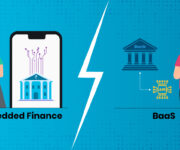The traditional banking setup has seen a complete overhaul with increasing technological advancements. It may seem like a new world, from loans in 59 minutes to digital wallets. All this has been made possible by embedded finance, which allows the integration of financial services into non-financial services.
Its ecosystem is anticipated to grow at a CAGR of 30.4% from 2022 to 2029. This growth is mainly fueled by its potential benefits to all stakeholders, from lenders to intermediaries to customers.
Services embedded on third-party platforms increase customer engagement. However, as it involves data sharing, it also puts personal data at risk of security challenges, underscoring the need for prompt solutions.
In this article, let’s go through some significant security challenges in embedded finance and how they can be addressed.
Embedded Finance: An Outline
Embedded finance reduces friction in services by allowing access to multiple services in one place. For instance, you can buy travel insurance directly while buying airline tickets on the same website. The linkage is done through application programming interfaces (APIs).
Additionally, it presents opportunities for financial inclusion, partnerships, and collaborations, as well as the development of new business models.
For example, the buy-now-pay-later (BNPL) trend has increased conversion rates for e-commerce platforms.
The embedding of financial services into everyday customer transactions has the potential to empower the unbanked and targeted groups.
Key Components of Embedded Finance
- Application programming interface (APIs): Ensures seamless incorporation of financial services in non-financial platforms.
- Real-time financial transaction: Allows instant access to services like payments, investments, lending, etc.
- Customer-centric services: Create frictionless services that eliminate the need to switch between different applications.
- Security and Compliance: The exchange of sensitive data is protected via robust security measures and strict adherence to regulatory standards.
- Innovative collaboration: Dynamic partnerships allow for new innovative offerings for the customers, benefiting all stakeholders.
Major Security Challenges in Embedded Finance
While there are multiple opportunities for the ecosystem to drive embedded finance capabilities, there are certain security challenges that lenders must tackle:
1. Data Privacy and Third-party Risks
There is an exchange and transfer of financial information between multiple stakeholders, prone to cybersecurity threats.
Further, the security framework of non-financial platforms isn’t as robust as banking platforms to handle sensitive information breaches, putting the entire ecosystem at risk.
A Verizon 2024 study found that 15% of data breaches faced by organisations were due to a third-party vendor, a 68% increase from last year.
2. Identity Theft
The usage of advanced technologies like deep fakes makes account takeovers and identity thefts easier for cybercriminals. Moreover, the loopholes in regulations and algorithms make systems vulnerable to unauthorised access.
A report by BioCatch mentions that 55% of fraud cases are account takeover cases in India.
3. Complex regulatory frameworks
The ecosystem involves multiple stakeholders from various industries. Navigating regulatory compliance becomes complex and costly amid ever-evolving rules and technical capabilities.
Thus, having a one-stop regulation could be challenging, especially for globally operating platforms.
4. Customer acquisition
The embedded ecosystem allows for a more comprehensive reach of the customer base, providing easy access to financial services on apps and websites.
However, risk profiling of customers and ensuring the correctness of information may be compromised compared to traditional banking systems, which have dedicated platforms for customer acquisition.
Emerging Solutions to Embedded Finance Security Challenges
The following emerging solutions for security challenges will help lenders use the embedded finance ecosystem at its best:
1. Data Protection
Adoption of end-to-end encryption ensures secure transmission of data, making it difficult for unauthorised access.
The initiative of card tokenisation can be further extended to other sensitive and personal information, reducing identity theft cases.
2. Risk Management
Financial and non-financial institutions must implement a comprehensive risk management strategy to evaluate unique risks associated with embedded finance and manage risks accordingly.
For example, Visa’s advanced authorisation system uses pattern analysis for fraud detection.
Also, opting for a zero-trust architecture for third-party risk management would ensure internal threats can be avoided. This will also include due diligence while partnering, regularly auditing their security frameworks, and establishing strict security standards.
3. Regulatory Standards
Establishing interoperability and dedicated regulatory standards for the embedded finance ecosystem is necessary for the seamless integration of services.
Using automated compliance tools, the compliance process can be made more efficient and economical. It allows for the seamless following of regulations across regions.
4. Consumer Awareness
Financial and non-financial platforms must collaborate to bring awareness regarding embedded ecosystems among consumers to ensure they are aware of risks and how to avoid them.
Further, establishing a grievance redressal mechanism will help promptly address security challenges.
The Takeaway
Embedded finance is poised to address multiple drawbacks of the traditional banking system. It has made access to financial services more seamless than ever. However, addressing security challenges is crucial to protect all stakeholders.
Financial institutions that promptly strengthen security measures will be better positioned in a rapidly evolving embedded finance ecosystem.
Finezza’s innovative Loan Origination Software offers easy and secure integration with APIs. It provides a single automated platform, which, along with operational efficiency, ensures secure data integration and improves customer experience.
The Loan Management System can help you track and manage credit applications, process KYC documents faster, and assess lending risks. Its robust risk assessment tools ensure you can manage your third-party risk efficiently, assuring the security of your operations.
The Mobile app ecosystem further integrates all services needed throughout the loan lifecycle. Further, the advanced analytics and real-time insights ensure you can make more informed decisions.
Request a demo today!




Leave a Reply